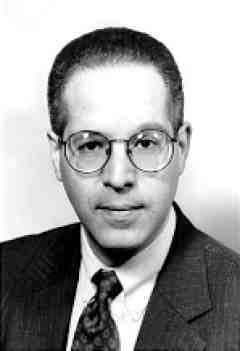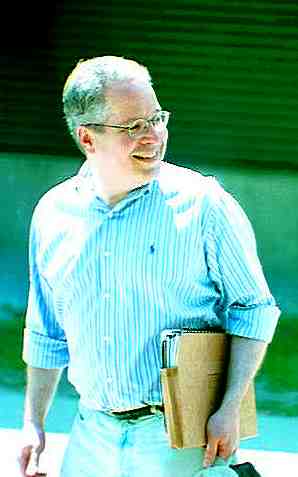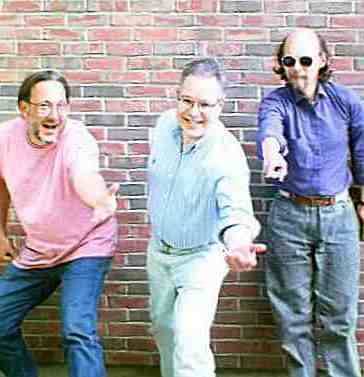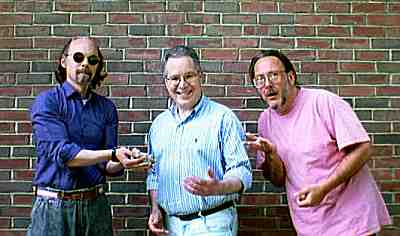Composer Profiles
Robert D. Polansky
 Robert D. Polansky
Robert D. Polansky
Listen to this show
 |
Robert D. Polansky
 for RealAudio comments by the composer, 3:08.
for RealAudio comments by the composer, 3:08.
Robert D. Polansky was born in 1951 in Newton, Massachusetts and, except for a brief sojourn as an undergraduate in the Midwest, has been a life-long resident of New England. Mr. Polansky earns his living as a financial manager in the publishing industry but devotes much of his spare time to composing. He has written a variety of instrumental and vocal works, several of which have been performed by prominent groups in the greater-Boston area. Past performances of his works include the premieres of Prayer of Moses, Man of God, by the Heritage Chorale of Framingham, and Concerto Grosso Moderno, by the Pro Arte Chamber Orchestra of Boston. The Heritage Chorale has also performed Mr. Polansky's Songs of Ancient Zion and Jerusalem 3000, which was composed especially for the Chorale in honor of its sixtieth anniversary. His sacred works have also been incorporated into liturgical service by various Boston-area synagogues. Other noteworthy performances include the premiere of Magrepha, a new organ work written for the Musical Celebration Series held by Rodgers Organs of New England. Mr. Polansky holds a BS degree in music composition from Oakland University, an MFA degree in music history from Brandeis University, and has published articles in the Journal of the American Musicological Society and Fontes Artis Musicae.

Prayer of Moses, Man of God
According to tradition, Psalm 90 was originally written by Moses and selected by King David for inclusion in the Sefer Tehillim (Book of Psalms). This fanciful attribution is made according to the caption at the heading of the Psalm, "Prayer of Moses, Man of God," which I also take for the title of my setting of selected verses from the Psalm (vs. 1-4, 10, 12, and 17). Psalm 90 is generally interpreted as a profound statement of the human condition, which, as the Psalmist writes, "is replete with labor and grief [vs. 10]." But it is also an affirmation of faith in God, and an avowal that through spiritual renewal, man can find purpose and meaning. As the Psalmist further writes, "So teach us to number our days that we may have a wise heart [vs. 12]." Affirmation, Affliction, Repentance, and Renewal are the four stages of manís spiritual search for purpose and meaning that are made manifest in Psalm 90 and that, together with a Prologue, correspond to the movements of my setting of Psalm 90.
The first movement, Prologue (vs. 1), is a stately declaration that invokes a feeling of profound spiritual faith. To render this effect, the saxophone first plays a steady, quiet, and even phrase that is imitated by the strings and then sung by the chorus to the words, "Lord, you have been a home for us from age to age." The second movement, Affirmation (vs. 2), continues to expound on the idea of faith. Here, the tenor soloist sings the words, "Before the mountains were born and the world was created, You are God for all eternity [vs. 2]." The soloist is accompanied by a repeated, syncopated rhythm in the strings that is articulated by the bongo drums. The rhythm and use of percussion create a somewhat pagan effect, which represents manís earliest awareness of Godís timeless presence.
The third movement, Affliction (vs. 3-4), in contrast to the preceding movements, reveals the Psalmistís crisis of faith. The piece begins with the chorus singing, in a hushed tone, two slow-moving, mildly dissonant chords to the ancient Hebrew word, daka, meaning "crushed." The word appears in the original, Hebrew language version of verse 3, which in translation reads, in part, "You return man to a crushed state [that is, dust]. Right after the intonation of daka, the chorus sings the complete third verse ending with, "You say: Return [to dust], O children of men!" To accompany the chorusí intonation of daka, the strings play an agitated, tremolo chord. After a sufficiently intense atmosphere is created, the strings abruptly drop away as the chorus quietly modulates to the next chord. In due course, the strings re-enter with their undulation. The entire effect is meant to depict the meaning of the word daka and its relevance to the feeling of affliction inherent in the text.
The fourth movement, Repentance (vs. 10 and 12), resolves the spiritual conflict portrayed in the previous movement. It is a subdued soprano solo whose nostalgic melody reflects manís acceptance of his fate and his reliance on Godís wisdom. The entire work concludes with the fifth movement, Renewal (vs. 17), which is essentially a reaffirmation of faith. The idea of renewal, or return, is reflected by the recapitulation at the end of the movement of the music from the Prologue, but sung to the final supplication, "...and [let the Lord] guide the work of our hands."
Concerto Grosso Moderno
The idea of writing the Concerto Grosso Moderno was inspired by the popular concerti grossi of the Baroque era, whose format, I surmised, is an equally befitting way of evoking the aesthetics of modern music. When translated into modern terms, the concerto grosso, through its use of two contrasting instrumental groups, provides an ideal platform for expressing those attributes of modern music--namely, conciseness, cohesion, and clarity--that I value most and for which I always strive. In the Concerto Grosso Moderno, conciseness is attained through the use of only several, succinct thematic ideas; cohesion, by building up the work from transformations of those ideas; and clarity, by means of articulating the boundaries of those transformations with alternating ensemble and tutti passages throughout the entire work. It is the idea of contrast, as a basic element of any concerto grosso, traditional or modern, that provides not only clarity, but also the pportunity for sufficient development within a short span of time so that depth is not sacrificed for the sake of conciseness.
There are three movements to the Concerto Grosso Moderno. To begin the first movement, the double basses strike a low f-sharp three times, which ushers in an agitated, tremolo chord played by the main string orchestra. The tremolos begin to slowly die away as one of the solo violins plays a lyrical, but slightly articulated, five-note motive (Motive I) accompanied by the solo viola. The other solo violin then responds with a highly expressive melodic line in its upper register (Motive II). The two ideas introduced by the solo violins at the very opening form a nucleus from which substantially all other thematic material in the work is derived.
The second movement is for the three soloists (two violins and viola) alone, an effect that is reminiscent of the traditional concerto grosso. All three soloists begin with the same theme, derived from Motive I. Each part, however, plays the tune at a different rate of speed. For contrast, the solo viola plays its version of the theme pizzicato, giving the movement a somewhat jocose feeling. The ensemble intermittently digresses into more lyrical episodes, always returning to the initial idea.
The third movement opens with a transformation of Motive II. Here, the motive is transformed from a lyrical, expressive line into a more dramatic contour. It is broken apart, apportioned between different parts of the orchestra, and punctuated by staccato chords. The solo ensemble further develops this material in contrapuntal fashion. At the conclusion of the work, the components are reassembled and the complete motive is decisively stated by the entire orchestra and solo ensemble together.
K&D do the Dances of Ancient Zion with Robert D. Polansky

Songs of Ancient Zion
The Hebrew texts for the Songs of Ancient Zion are those of Psalm 121 (Guardian of Israel) and Psalm 150 (Chorus of Praise). Psalm 121 comes from the group of fifteen psalms (Psalms 120-134) known as Songs of Ascent, which, according to classical Rabbinic writings, were sung by the ancient Levites (priestly assistants) on the steps (hence, "ascent") of the Holy Temple in biblical Jerusalem. It is also thought that the Songs of Ascent were recited by the ancient Israelites while on pilgrimage to Jerusalem, the journey being a spiritual as well as geographic ascent.
Psalm 150, the concluding psalm in the biblical Book of Psalms, is a final hymn of praise, and because of a reference to various musical instruments in many of its verses, it has proved irresistible to many composers, including Stravinsky, who used it (in its Latin translation) in the third movement of his Symphony of Psalms. Only one of the biblical instruments mentioned in the Psalm, the shofar, is still in use today in Jewish worship, and no instruments from the period are still extant. Therefore, we can only make reasonable, educated guesses about what these instruments were really like. The modern terms used in the English translation, trumpet, pipes, lute, etc., are only meant to provide an idea of the nature of the instruments so far as we can discern from descriptions in post-biblical writings.
Guardian of Israel, the first of the two pieces in the work, begins with a rising melodic line in the sopranos that is sung to the well-known opening verse, "I lift my eyes to the mountains." The rising contour of the melodic line is, of course, a musical way of depicting the lifting of one's eyes. Moreover, the idea, per se, of an ascending melodic line serves as a musical reference to the entire collection of Songs of Ascent, from which the text is taken. Guardian of Israel concludes by incorporating in its last line the first half-verse of the text of Chorus of Praise, the second piece of the work. When the phrase is repeated as the opening line of Chorus of Praise, it is, of course, in entirely new musical garb; nevertheless, the textual overlap brings the two pieces together as a unified pair.
In all other respects the two movements of Songs of Ancient Zion contrast musically with one another. Guardian of Israel is serious and contemplative, in a way that reflects the consoling nature of the text. Chorus of Praise, on the other hand, is lively and jubilant, so that it may express the laudatory purpose of the text.
Jerusalem 3000
Jerusalem 3000 was composed especially for the Heritage Chorale, in honor of its sixtieth anniversary. It was also composed to commemorate the three-thousandth anniversary of the establishment of Jerusalem as the capital of the Land of Israel. Both milestones are being celebrated and observed in 1996.
Jerusalem, throughout its long history, has served as the spiritual center of Western civilization, and has done so, in large part, through music. This is evident from the earliest biblical accounts, in which song and instrumental music are described as an integral part of daily worship in the ancient temple. The texts of those Levitical songs--the biblical Psalms--have inspired modern composers to write some of their most enduring works, such as Stravinsky's Symphony of Psalms, Bernstein's Chichester Psalms, and Kodaly's Psalmus Hungaricus, just to name a few. These modern works are a testimony to the ancient legacy of sacred music and poetry associated with Jerusalem. Many of them have been sung by the Heritage Chorale during its prestigious tenure, so it is befitting that the Chorale is honored with yet another Psalm setting--namely Jerusalem 3000.
The text of Jerusalem 3000 is comprised of just three verses taken from Psalm 122: "I rejoiced when they said to me, let us go to the house of the Lord. For there sit thrones of judgment, thrones for the house of David. Pray for the Peace of Jerusalem, they that love you shall be at ease." The phrase "house of the Lord" is of course a reference to the ancient temple of Jerusalem, and the phrase "house of David," a reference to King David, who captured Jerusalem from the Jebusites in 1004 B.C.E. King David is traditionally accepted as the author of many of the biblical psalms and, as is well-known, is reputed to have been an accomplished musician.
The three verses of Psalm 122 selected for the text of Jerusalem 3000 together invoke a powerful triad of ideas: jubilation, judgment, and peace. The music thus begins in a lively manner, in order to reflect the idea of jubilation, but then subsides to a moderate, contrapuntal section, in order to reflect the more serious and complex idea of judgment. The peace further unwinds into a calmer, more expressive section, in which a solo voice sings the well-known verse, "Pray for the Peace of Jerusalem." The initial, three-fold progression of mood and feeling in the piece--from lively, to serious, to calm--is meant to mirror the succession of images invoked by the triad of ideas. Subsequently, all three verses are sung a second time, but for the recapitulation of the third verse, the work unexpectedly diverts and builds to a broad and majestic declaration of the phrase "Pray for the Peace of Jerusalem," with which the piece concludes.
Magrepha
Magrepha takes its title from the name of an organ-like instrument allegedly found in the Holy Temple in biblical Jerusalem. According to early Medieval rabbinic sources, the magrepha was in the shape of a box that was "one cubit long and one cubit high, from which projected a handle with ten holes. Each hole was capable of producing 100 kinds of sounds for a total of 1,000 kinds of sounds [Talmud Bavli, Massachet Aruchin ff. 10b-11a]." Little else is known about the ancient magrepha, except that the literal meaning of the Hebrew word "magrepha" ("rake") probably refers to the shape of the handle protruding from the main body of the instrument. Exactly how the magrepha sounded is unknown, as the original, if it ever really existed, is not extant. Moreover, the rabbinic description cited above does not provide sufficient information about the magrepha from which we can build a modern replica. Magrepha, therefore, is not an attempt to recreate the authentic sound of the magrepha; instead, it is solely a modern interpretation of how I imagine the ancient instrument might have sounded.
Jam Session
According to jazz parlance, a jam session is an impromptu gathering of musicians for the purpose of extemporizing. It is a way for musicians to find the boundaries of their musical expression unfettered by the demands of public performance. Jam Session is not, of course, the product of any late-night closed-door session of musicians. Instead, it is intended to reflect the eclectic mood and feeling that one might expect to hear in an authentic jam session.
There are five movements to Jam Session. The first is fast and lively and makes use of jazz-like syncopated rhythms. This is followed by a serious, modernistic piece with angular polyphonic lines that weave around one another. The middle movement strikes a balance between the first two. It fuses together the modern-style harmonies found in the second movement with the syncopated rhythms that characterize the opening piece. The work, however, settles back in the fourth movement, which is slow, lyrical, and expressive. The entire work concludes with a boisterous piece that trails off into polytonality and near cacophony, as if the musicians have lost all inhibition in their final jam.
SELECTED WORKS LIST
- Sayings of the Fathers, voice and piano
- Ahava Rabah, voice and piano
- All But the Ties Eternal, voice and piano
- What Will and Edna Had to Say About Love, voice and piano
- Songs of Ancient Zion, mixed choir, a cappella
- Jerusalem 3000, mixed choir and piano
- Song of Enlightenment, mixed choir and piano
- Five Midrashim, piano solo
- Magrepha, organ solo
- Burlesca, clarinet and piano
- Concerto Grosso Moderno, two violins, viola, and string orchestra
- Prayer of Moses, Man of God, chorus and small orchestra
- Grow Old Along With Me, chorus and piano
- When Soft Voices Die, voice and piano
- Beatitudes, solo flute, with narration and dance
- Winds of the Heavens, flute trio
- Dedication of the House, voice and piano
- Imitations, for four solo violins
- Fantasy-Improvisation, violin duet
- Three Pieces for Piano
- Words of My Mouth, Meditations of My Heart, cello and piano
To reach the composer:
On-line: rdpolansky@verizon.net
By telephone:
By fax:
By physical mail:
Robert D. Polansky with the K&D mafia at the studio



 Robert D. Polansky
Robert D. Polansky


